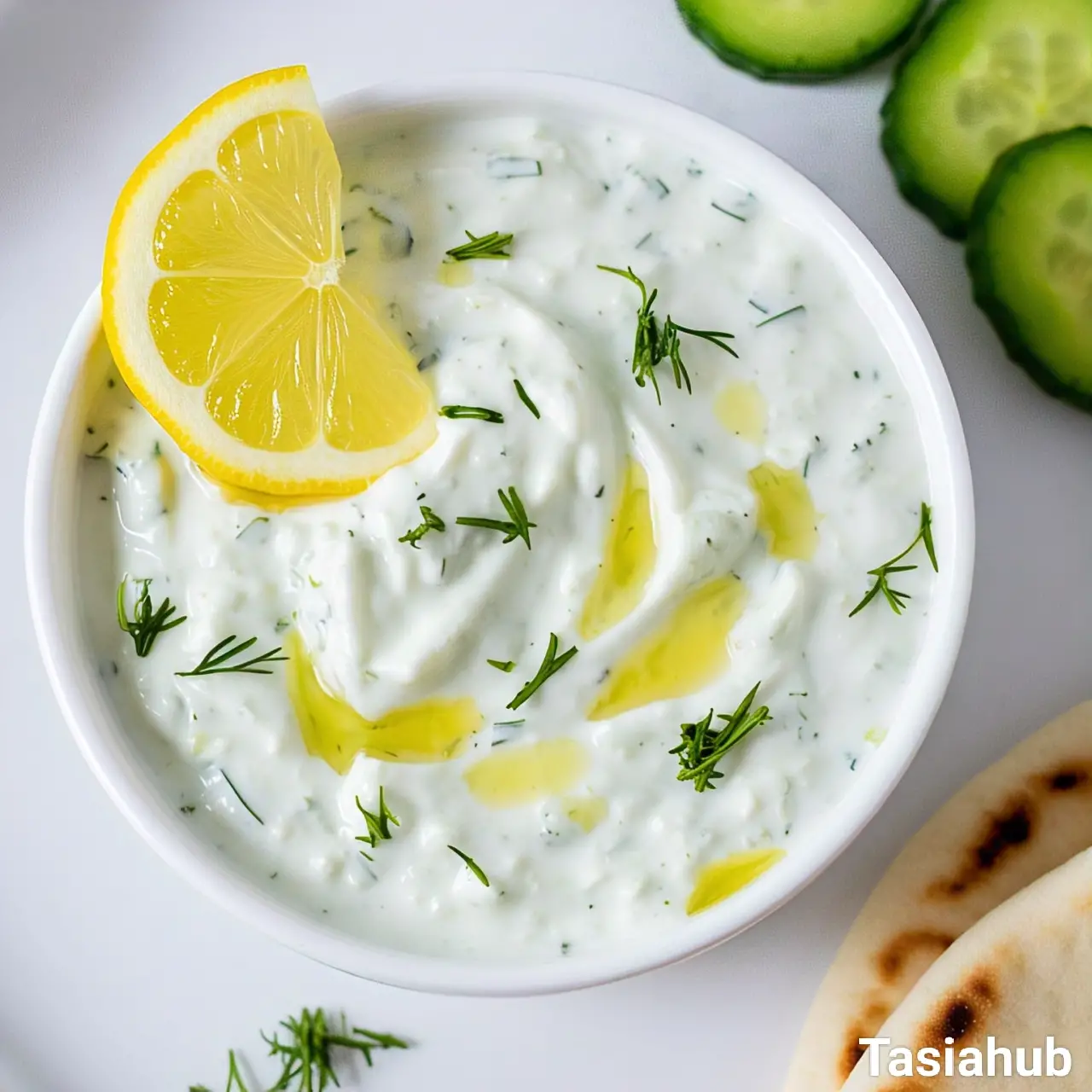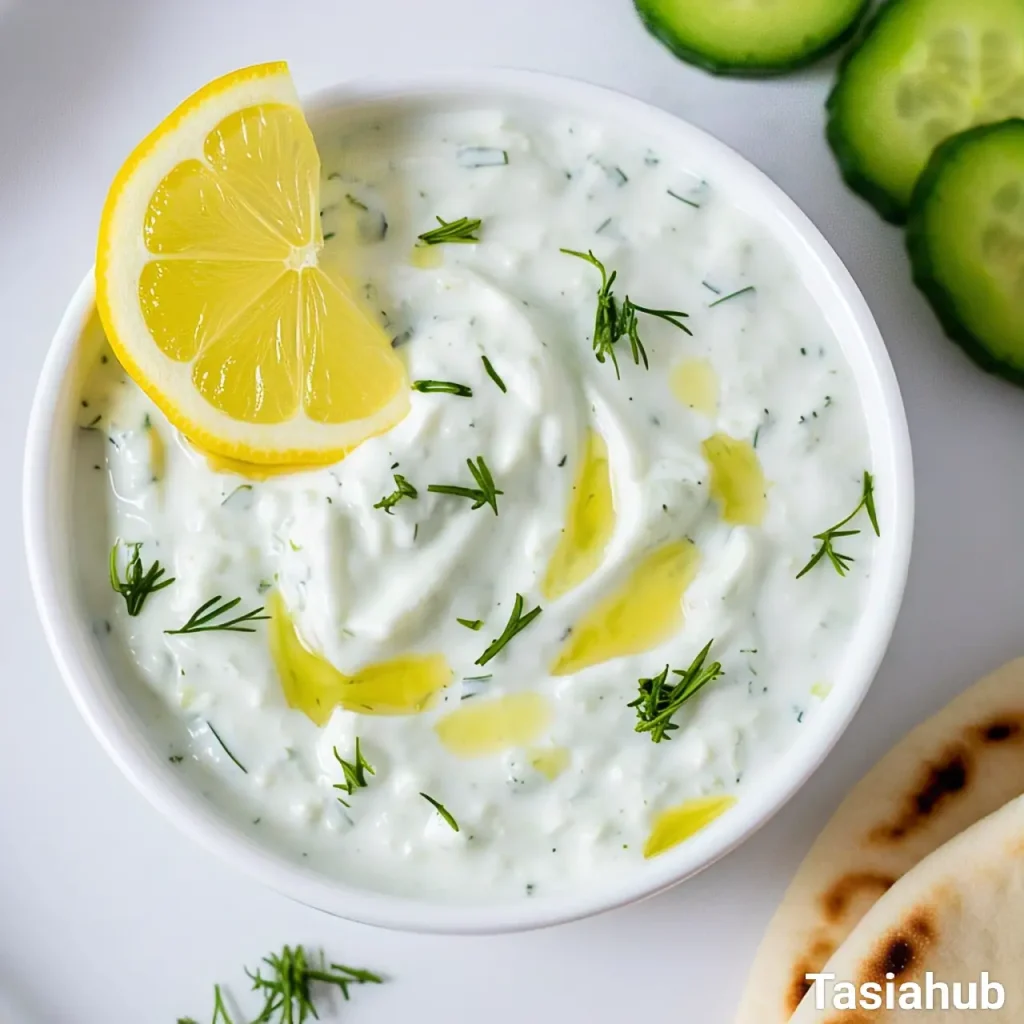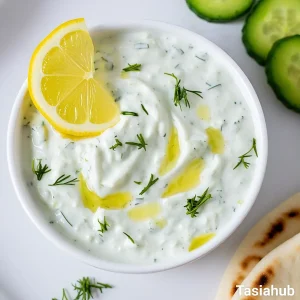Tzatziki Sauce

If you’ve ever enjoyed Mediterranean food, you’ve likely encountered tzatziki sauce. This creamy, refreshing sauce is a staple in Greek cuisine and is the perfect accompaniment to a variety of dishes.
Whether you drizzle it over a grilled chicken gyro, dip crispy pita bread into it, or use it as a salad dressing, tzatziki adds a burst of flavor and coolness that’s hard to beat.
But let’s talk about what makes tzatziki so special. It’s a perfect balance of tangy yogurt, cool cucumber, and zesty garlic, with a hit of fresh herbs like dill or mint. What’s even better is that it’s ridiculously easy to make at home, and once you taste your fresh version, you’ll never go back to store-bought again.
You can whip it up in a matter of minutes, and it’s a fantastic addition to everything from a casual snack to a full Mediterranean feast.
The best part? It’s not just delicious, it’s healthy too! Greek yogurt is packed with probiotics, cucumbers are hydrating, and fresh herbs add an extra source of antioxidants.
Tzatziki is the perfect example of a sauce that’s both good for you and incredibly tasty. So, if you’re looking to elevate your next meal, keep reading — this tzatziki recipe is about to become your new go-to!
Why You’ll Love It
- Simple & Quick: With just a handful of ingredients, you can whip up this creamy sauce in no time. It takes about 10 minutes to make, so you can have it ready for your next meal without any hassle.
- Versatile: Tzatziki isn’t just for gyros. It works as a dip for veggies, a topping for grilled meats, a spread on sandwiches, or even a salad dressing. You’ll find yourself reaching for it all the time!
- Healthy: Packed with the goodness of Greek yogurt, cucumbers, and fresh herbs, tzatziki is a light and nutritious option compared to other heavier sauces. Plus, it’s naturally gluten-free and can easily be made dairy-free with plant-based yogurt.
- Refreshingly Cool: The combination of cucumber and yogurt creates a refreshing, cooling effect that’s perfect for balancing out spicier foods or adding a burst of freshness to your plate.
- Customizable: You can adjust the flavors to your taste. Want a little more garlic? Add it in! Prefer a minty twist? Toss in some fresh mint leaves. Tzatziki is super easy to customize to your liking.
Ingredient List
- For the Tzatziki Sauce:
- 1 cup Greek yogurt (preferably full-fat for creaminess)
- 1/2 cucumber, finely grated or diced
- 2 tablespoons olive oil
- 1 tablespoon fresh lemon juice
- 2 cloves garlic, minced
- 1 tablespoon fresh dill, chopped (or 1 teaspoon dried dill)
- Salt and pepper, to taste
- Optional Garnishes:
- Extra dill or mint for a fresh touch
- A drizzle of olive oil
Ingredient Notes
- Greek Yogurt: I always use a thick, full-fat Greek yogurt for a creamier texture. If you want a lighter version, you can substitute with low-fat or non-fat yogurt.
- Cucumber: Make sure to grate or finely dice the cucumber and drain out the excess water to prevent your tzatziki from becoming too runny.
- Olive Oil: Use high-quality extra virgin olive oil for the best flavor. It adds richness to the sauce and enhances the taste.
- Fresh Garlic: Fresh garlic gives the tzatziki its bold flavor, so don’t skip it. If you want it milder, reduce the amount.
- Fresh Herbs: Fresh dill is traditional, but you can also try fresh mint for a different flavor profile! Just make sure to chop it finely.
Kitchen Equipment Needed
- Grater: For finely grating the cucumber. I prefer a box grater because it gives a nice, even texture.
- Mixing Bowl: To combine all the ingredients. A medium-sized bowl works best for this recipe.
- Garlic Press: For mincing the garlic easily. If you don’t have one, a knife will do, but a press saves time.
- Cutting Board & Knife: For chopping fresh herbs and garlic. A sharp knife ensures clean cuts.
- Spoon or Whisk: To stir everything together and get a smooth consistency. I like using a spoon for easy mixing.
Instructions
Step 1: Prepare the Cucumber
- Start by washing the cucumber thoroughly.
- Use a grater to finely grate the cucumber (you can also dice it into small pieces if you prefer a chunkier texture).
- Once grated, place the cucumber in a clean kitchen towel or paper towels, and gently squeeze to remove excess water. This helps prevent your tzatziki from becoming too watery. Pro Tip: Don’t skip this step! Removing the excess water is key to achieving the perfect consistency.
Step 2: Mince the Garlic
- Peel the garlic cloves and finely mince them using a garlic press or a sharp knife.
- If you like a stronger garlic flavor, feel free to add more, but keep in mind it can get intense, so start with two cloves.
Step 3: Combine the Ingredients
- In your mixing bowl, add 1 cup of Greek yogurt, the grated cucumber, minced garlic, and 1 tablespoon of fresh lemon juice.
- Stir everything together gently using a spoon or whisk. This helps to distribute the cucumber and garlic evenly throughout the yogurt.
Step 4: Add the Seasonings
- Now, add 2 tablespoons of olive oil, 1 tablespoon of chopped fresh dill (or mint, if you’re using it), and salt and pepper to taste.
- Stir everything together until well combined. Pro Tip: Taste your tzatziki as you mix — if you like a bolder flavor, add more lemon juice, garlic, or dill.
Step 5: Let It Chill
- Cover the bowl with plastic wrap or a lid and place it in the fridge for at least 30 minutes. This allows the flavors to meld together and gives you a perfectly chilled, refreshing sauce.
Step 6: Serve and Enjoy
- When ready to serve, give the tzatziki a quick stir and transfer it to a bowl or use it as a topping for your dish.
- Garnish with a drizzle of olive oil or more fresh dill or mint for an extra touch.
Enjoy your homemade tzatziki with your favorite Mediterranean dishes!

Tips and Tricks for Success
- Use Full-Fat Yogurt: For the creamiest tzatziki, always opt for full-fat Greek yogurt. It adds richness and a smoother texture.
- Squeeze Out the Cucumber: Don’t skip the step of removing excess water from the cucumber. It makes all the difference in the consistency!
- Adjust the Garlic: Garlic flavor can vary depending on freshness. Start with 2 cloves and add more to taste, especially if you prefer a milder flavor.
- Chill for Best Flavor: Let the tzatziki chill in the fridge for at least 30 minutes to let the flavors develop and intensify.
- Make Ahead: Tzatziki can be made up to 2-3 days in advance, making it a great option for meal prep or entertaining.
Ingredient Substitutions and Variations
- Greek Yogurt: If you want a dairy-free version, substitute with a plant-based yogurt like coconut or almond yogurt. Make sure to choose one that’s thick and unsweetened for the best texture.
- Cucumber: You can swap cucumber for grated zucchini in a pinch, but make sure to squeeze out the excess moisture just like you would with cucumber.
- Herbs: If you don’t have fresh dill, you can use dried dill, though fresh is best. Alternatively, mint works wonderfully for a different twist on flavor.
- Lemon Juice: If you don’t have fresh lemons, bottled lemon juice can work, but fresh is always preferred for the best zingy taste.
- Olive Oil: You can use any mild olive oil, but extra virgin olive oil adds the best flavor. For a lighter taste, you can substitute with avocado oil.
Serving Suggestions
- Gyros: Tzatziki is the perfect topping for a classic Greek gyro. The cool, creamy sauce complements the savory grilled meat and fresh veggies wonderfully.
- Veggie Platter: Serve tzatziki as a dip for fresh veggies like carrots, cucumbers, and bell peppers. It’s a light and refreshing snack.
- Grilled Chicken or Lamb: A drizzle of tzatziki on grilled chicken or lamb adds a refreshing, tangy contrast to the savory meat.
- Pita Bread: Serve tzatziki as a spread on warm pita bread or as a dip for crispy pita chips. It’s a simple yet satisfying appetizer.
- Salads: Use tzatziki as a dressing for a Mediterranean-inspired salad with tomatoes, cucumbers, olives, and feta cheese.

Storage and Reheating Instructions
- Storage: Store tzatziki in an airtight container in the fridge. It will keep fresh for up to 3 days.
- Reheating: Tzatziki is best served cold, so there’s no need to reheat it. Simply take it out of the fridge and stir before serving.
- Make-Ahead: You can prepare tzatziki a day or two ahead of time. The flavors develop even more as it sits, making it an ideal make-ahead option. Just remember to give it a quick stir before serving!
Frequently Asked Questions
1. Can I make tzatziki without Greek yogurt?
Yes, you can substitute Greek yogurt with regular yogurt or even a plant-based yogurt for a dairy-free option. However, Greek yogurt gives the best creamy texture.
2. How can I make tzatziki spicier?
If you like some heat, add a pinch of cayenne pepper or some chopped jalapeños. It’ll add a nice kick without overpowering the flavor.
3. Can I freeze tzatziki?
Tzatziki doesn’t freeze well because the yogurt and cucumbers can separate. It’s best to enjoy it fresh, but you can store leftovers in the fridge for up to 3 days.
4. Can I use dried dill instead of fresh?
Yes, you can! If you’re using dried dill, start with about 1 teaspoon. Fresh dill has a more vibrant flavor, but dried dill works in a pinch.
5. What if I don’t have cucumber?
You can substitute cucumber with grated zucchini, but be sure to squeeze out the excess moisture. It’s a great alternative, though the flavor will be slightly different.
6. Can I add other herbs?
Absolutely! While dill is traditional, mint or parsley also work wonderfully in tzatziki, depending on the flavor profile you prefer.
Did you try this recipe? Let me know in the comments how it turned out!
Don’t forget to share your photos on Instagram and tag me (@tasiahub_) or use the hashtag (#tasiahub). I’d love to see your creations!

Tzatziki Sauce
Equipment
- Grater
- Mixing Bowl
- Garlic Press
- Cutting Board & Knife
- Spoon or whisk
Ingredients
For the Tzatziki Sauce:
- 1 cup Greek yogurt preferably full-fat for creaminess
- 1/2 cucumber finely grated or diced
- 2 tablespoons olive oil
- 1 tablespoon fresh lemon juice
- 2 cloves garlic minced
- 1 tablespoon fresh dill chopped (or 1 teaspoon dried dill)
- Salt and pepper to taste
Optional Garnishes:
- Extra dill or mint for a fresh touch
- A drizzle of olive oil
Instructions
Step 1: Prepare the Cucumber
- Start by washing the cucumber thoroughly.
- Use a grater to finely grate the cucumber (you can also dice it into small pieces if you prefer a chunkier texture).
- Once grated, place the cucumber in a clean kitchen towel or paper towels, and gently squeeze to remove excess water. This helps prevent your tzatziki from becoming too watery. Pro Tip: Don't skip this step! Removing the excess water is key to achieving the perfect consistency.
Step 2: Mince the Garlic
- Peel the garlic cloves and finely mince them using a garlic press or a sharp knife.
- If you like a stronger garlic flavor, feel free to add more — but keep in mind it can get intense, so start with two cloves.
Step 3: Combine the Ingredients
- In your mixing bowl, add 1 cup of Greek yogurt, the grated cucumber, minced garlic, and 1 tablespoon of fresh lemon juice.
- Stir everything together gently using a spoon or whisk. This helps to distribute the cucumber and garlic evenly throughout the yogurt.
Step 4: Add the Seasonings
- Now, add 2 tablespoons of olive oil, 1 tablespoon of chopped fresh dill (or mint, if you’re using it), and salt and pepper to taste.
- Stir everything together until well combined. Pro Tip: Taste your tzatziki as you mix — if you like a bolder flavor, add more lemon juice, garlic, or dill.
Step 5: Let It Chill
- Cover the bowl with plastic wrap or a lid and place it in the fridge for at least 30 minutes. This allows the flavors to meld together and gives you a perfectly chilled, refreshing sauce.
Step 6: Serve and Enjoy
- When ready to serve, give the tzatziki a quick stir and transfer it to a bowl or use as a topping for your dish.
- Garnish with a drizzle of olive oil or more fresh dill or mint for an extra touch.
Notes
Nutritional Value (per serving)
- Calories: ~70-90 kcal
- Protein: 4-6 grams
- Fat: 5-7 grams
- Carbohydrates: 4-6 grams
- Fiber: 0.5-1 gram
- Sugar: 3-4 grams
- Sodium: 50-80 mg
The nutritional information provided on this website is an estimate only and is intended for general guidance. We cannot guarantee its accuracy and recommend consulting a qualified healthcare professional or registered dietitian for personalized nutrition advice.